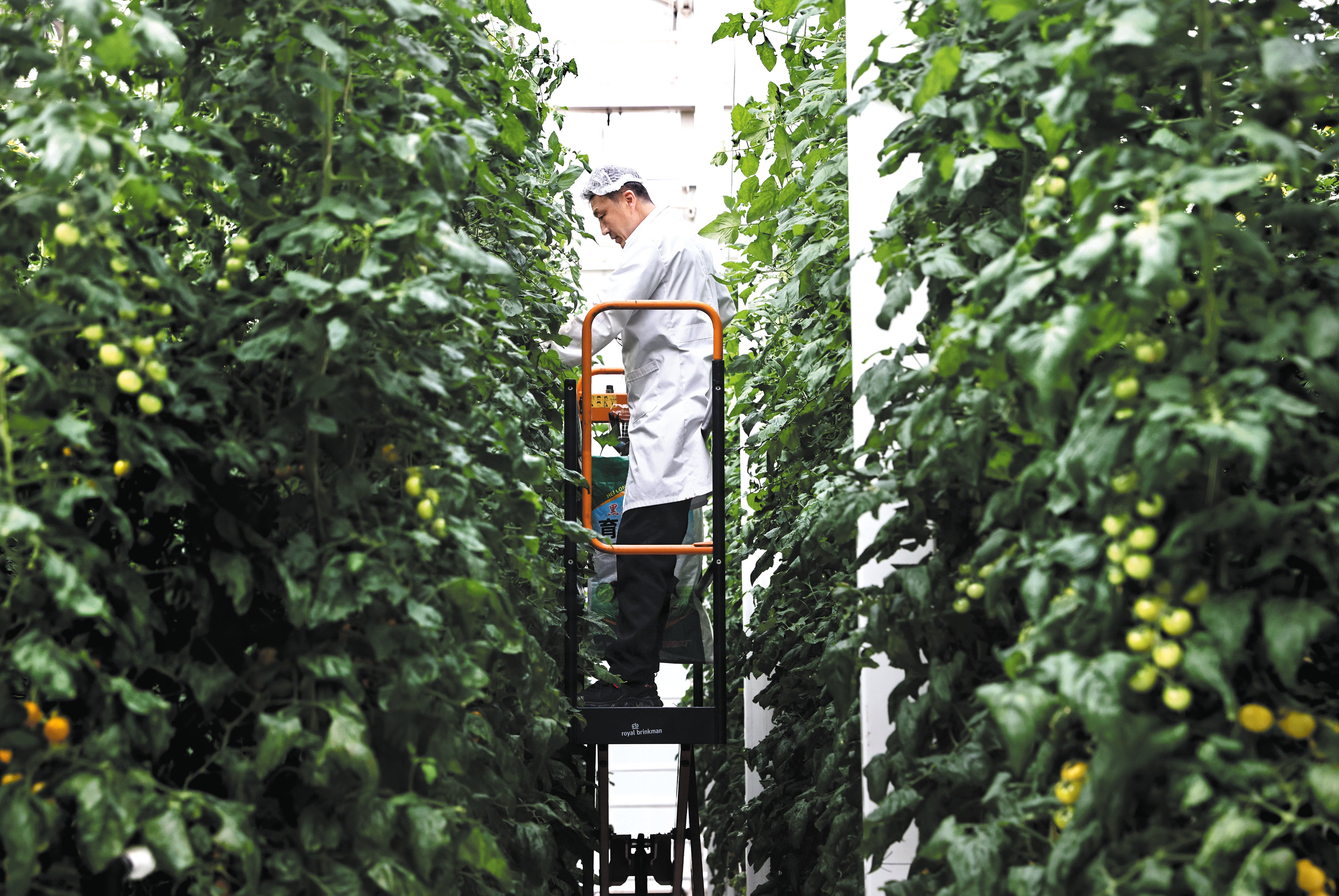Vertical farming reaches new heights
THE ARTICLES ON THESE PAGES ARE PRODUCED BY CHINA DAILY, WHICH TAKES SOLE RESPONSIBILITY FOR THE CONTENTS

Li Xinxu, 39, operates new-technology farming in a 120,000-square-yard greenhouse in a suburb northwest of Beijing.
Cherry tomatoes hang up to 13 feet high, ripening on tiered shelves in the greenhouse, where the temperature is maintained between 15C and 30C throughout the year. Worker bees occasionally emerge from hives in the structure.
Fruits and vegetables are nourished in liquid nutrient solutions, rather than being grown in soil, thanks to vertical farming. This agricultural technique was developed by scientists to overcome a lack of resources, particularly as the world’s population continues to rise.
The United Nations Food and Agriculture Organisation has said the global cropland area per capita fell from about 1.11 acres in 1961 to 0.52 acres in 2016. The UN also reported that the world’s population reached 8 billion in November 2022 and is expected to reach 9 billion by 2037.
Against this backdrop, vertical farming is seen as a way of maximising yield over a limited area by optimising resources and space.
As urbanisation accelerates in China, agricultural experts and leaders of new-farming companies are exploring ways to localise this agricultural technology to ensure that those living in cities have access to stable food supplies.
China’s urban population exceeded 920 million by the end of last year and will continue to rise, the National Bureau of Statistics said in January.
Vertical farming, first advocated by Dickson Despommier, a professor of microbiology at Columbia University in New York, involves growing local fresh produce in high-rise towers made from glass and steel.
He envisioned a 30-storey skyscraper able to provide food for 50,000 residents in downtown Manhattan, with about 160 such buildings providing food supplies for all the city’s residents throughout the year.
Abandoned garages and factories are ideal sites for vertical farming, with some farms in the US already producing vegetables in indoor or rooftop spaces, he said.
“Vertical farming enables plants to be grown in nutrient-rich water, with the light they require supplemented by artificial sources. Some resources considered useless in the city can be used in vertical farming, such as sewage and carbon dioxide in the air,” said Yang Qichang, deputy director of the Institute of Urban Agriculture at the Chinese Academy of Agricultural Sciences.
Fruit and vegetables grown indoors can resist insects and soil-borne plant diseases because they are grown hydroponically, meaning in sand, gravel, or liquid, with added nutrients but without soil. This method prompted Li Xinxu to set up his vertical farm in northwestern Beijing.
The farm’s first growing season started in September last year.
“In our first season I expect to achieve an output value of 40 million to 50 million yuan [£4.7 million to £5.8 million] by July,” said Li, now chief executive of Beijing Cuihu Agricultural Technology Co.
In China about 250 plant factories use vertical farming, Yang said.
Beijing AgriGarden Protected Horticulture Technology Co, established in 2002, was one of the first such companies in the country to use vertical farming. The company, located at the National Agricultural Science and Technology Innovation Park in the Zhongguancun area, boasts seedling laboratories, vertical farming planting areas, ecological meeting rooms and garden offices.
A workshop in the park, which grows cucumbers on an area of about 1,200 square yards, achieves a yield of more than 440lb, while strawberries planted at the farm boast a yield far superior to that of traditional planting methods.
Wei Lingling, chief executive of Beijing AgriGarden Co, said: “Harvesting of a single crop can only be achieved once or twice a year in field planting. But in our greenhouse laboratory we can harvest crops 12 times a year because the vegetables ripen every 28 to 30 days.”
Although large-scale commercial vertical farming is still not well established in China, real estate companies, local governments, schools and libraries nationwide have collaborated with Wei’s company in more than 100 vertical farming projects.
She foresees establishing small vertical farms in subway stations, so that when commuters finish work they can choose vegetables and take them home directly, rather than buying those transported from markets several hundred miles away.
“In this way, logistics costs will be cut and people will be able to obtain really fresh vegetables.”
Subscribe to Independent Premium to bookmark this article
Want to bookmark your favourite articles and stories to read or reference later? Start your Independent Premium subscription today.